
MINOX CAMERA
Oswald's Spy Camera
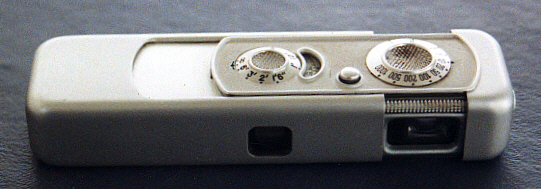
A Minox Spy Camera
While searching the contents of Lee Oswald's sea bag on the day after the assassination, Detectives Gus Rose and Richard Stovall discovered a Minox camera. Opening the camera, Rose discovered a roll of film inside it and recorded it in his inventory of items taken from the Paine house:

On November 26, 1963, two days after Oswald's death, Dallas police turned over the evidence to the FBI who took charge of the investigation. Every piece of evidence was cataloged, and signed for by FBI Agent Warren DeBrueys.

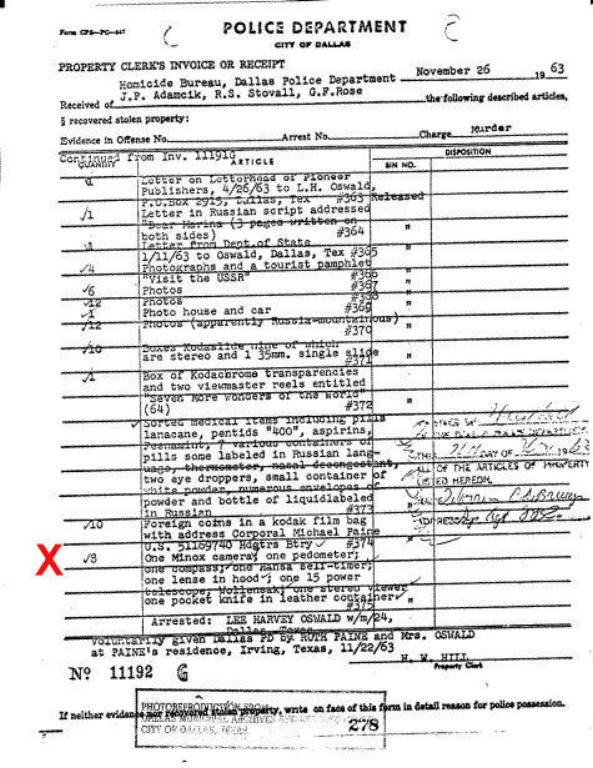
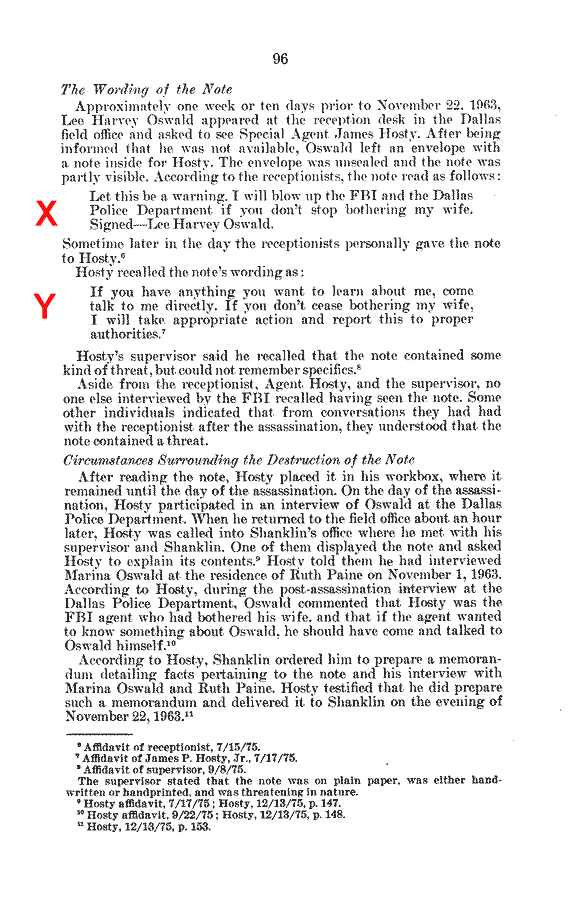
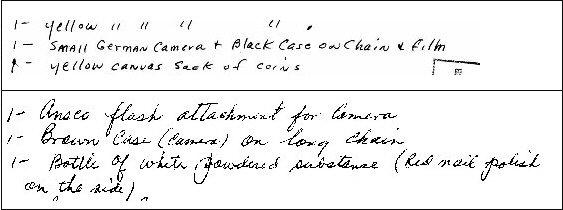
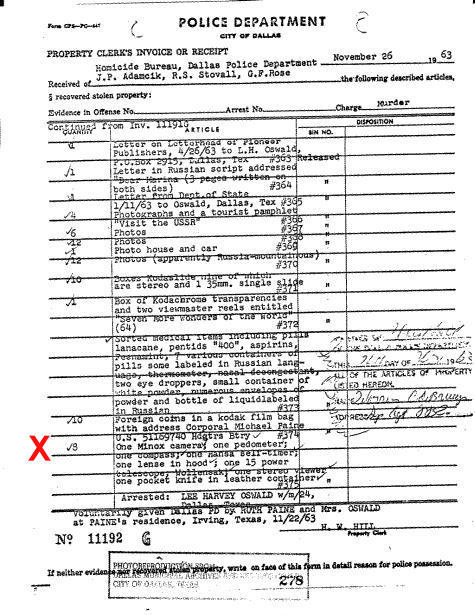

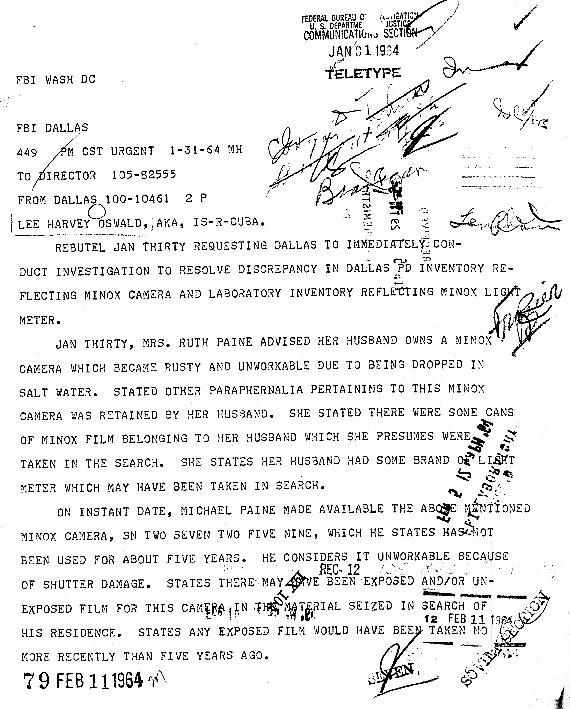
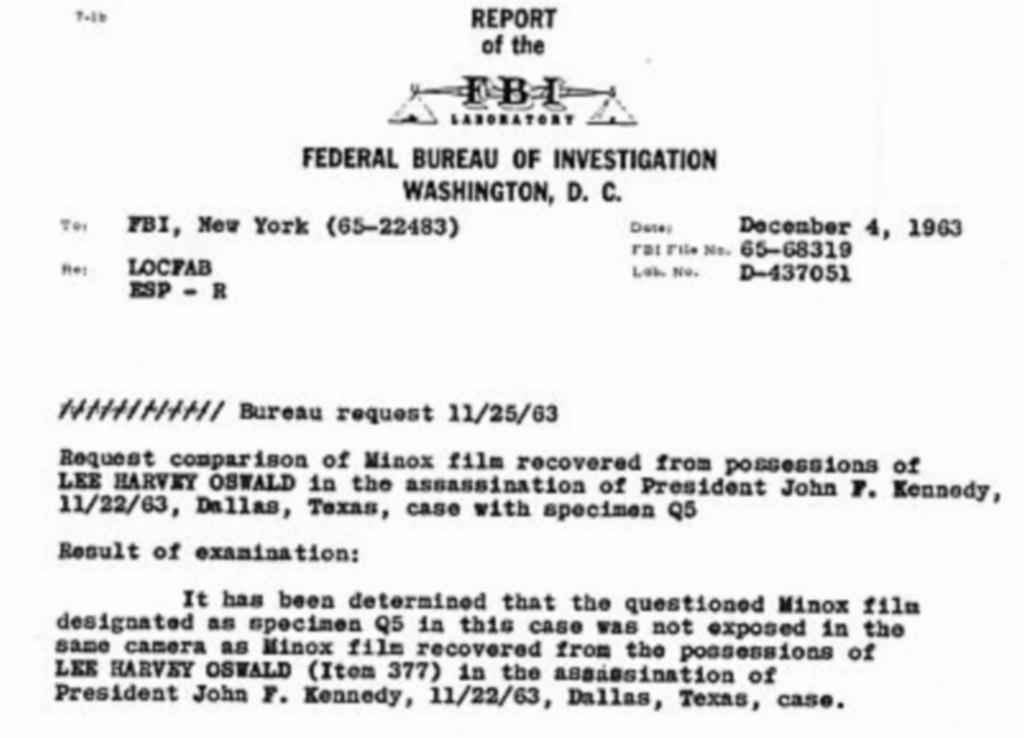

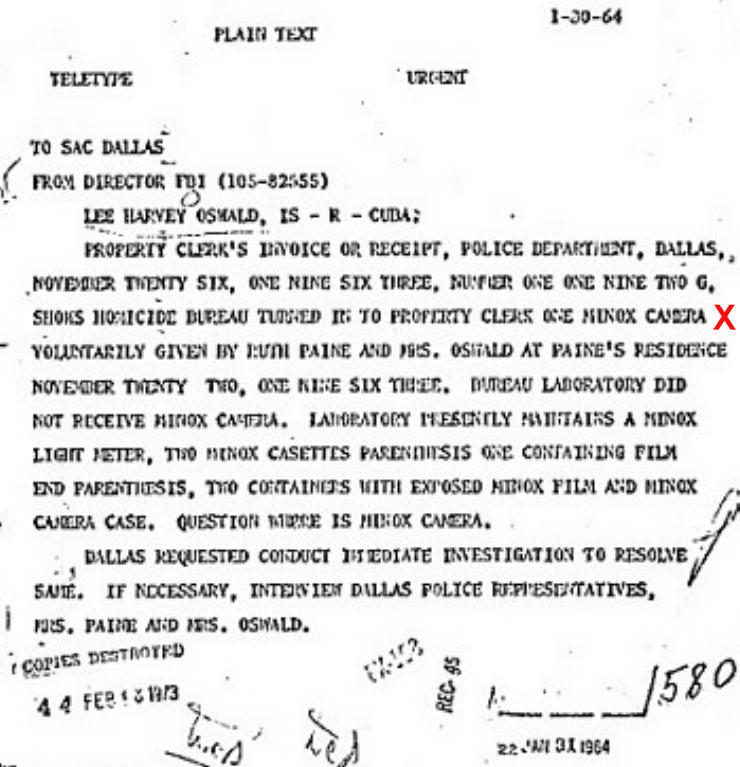
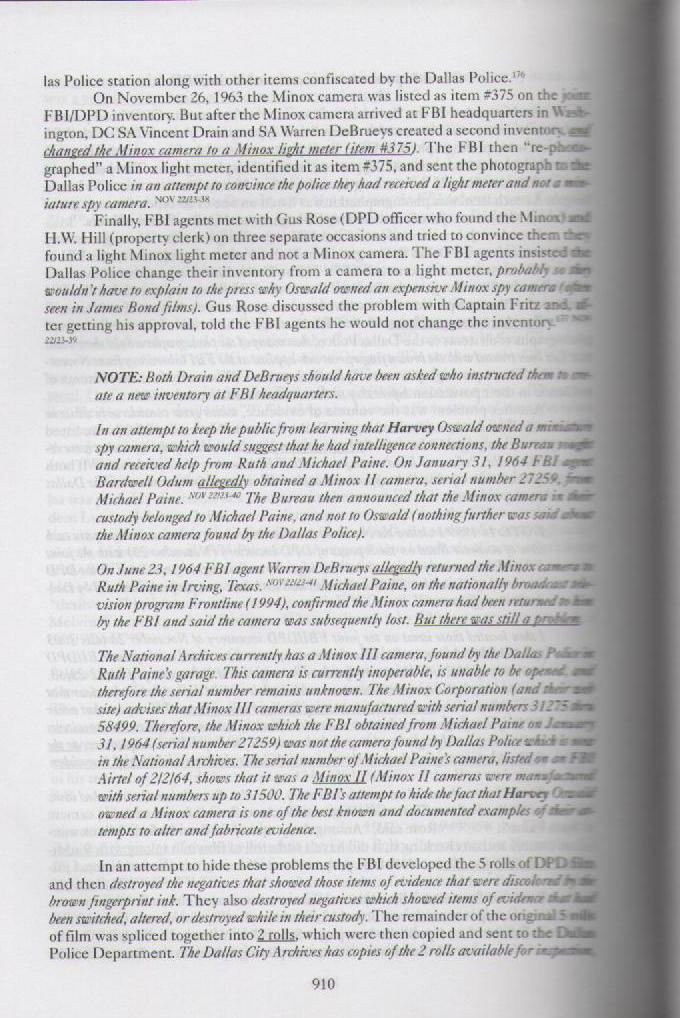

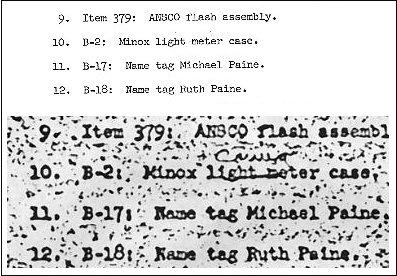
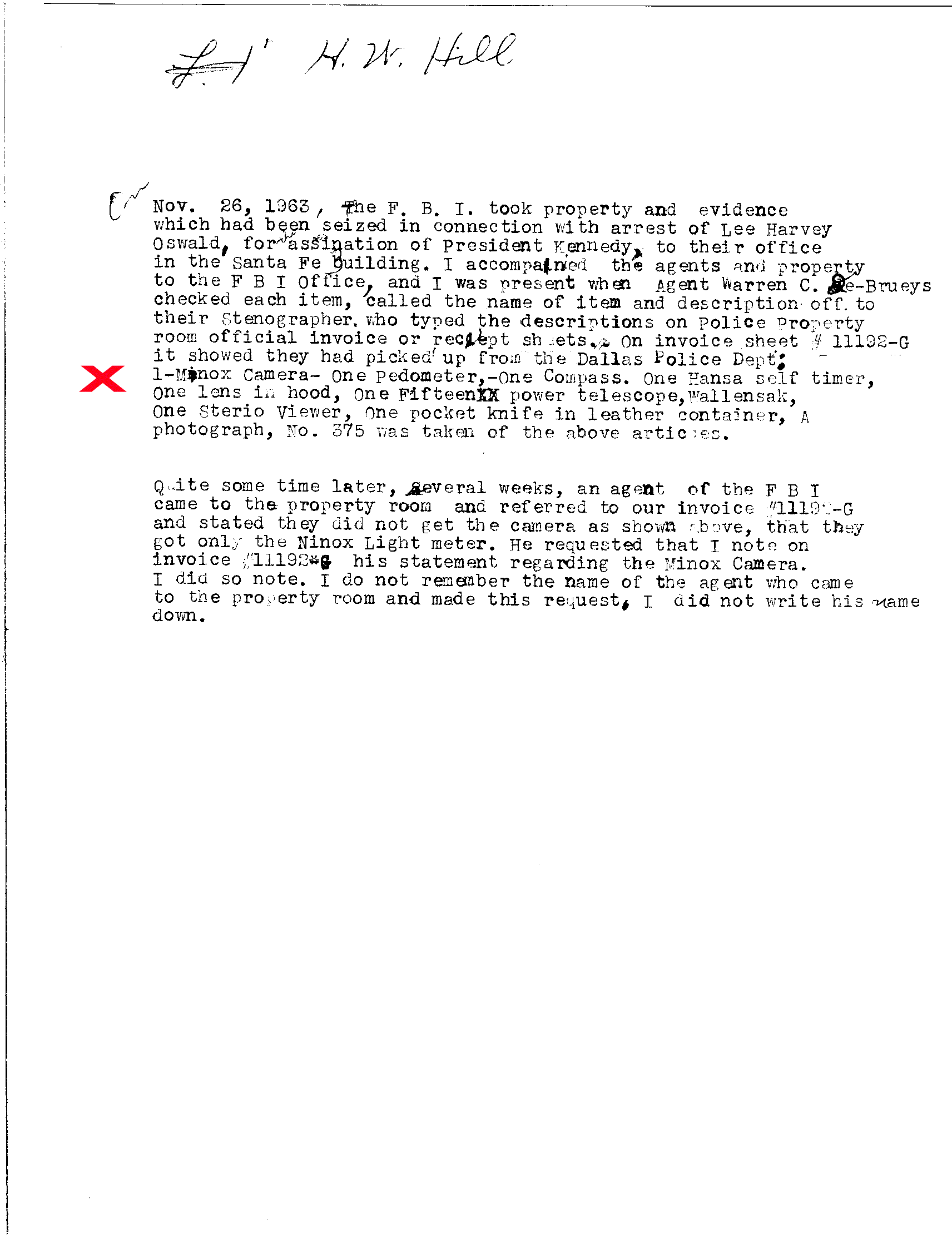
However, the FBI contacted Rose and Stovall and informed them that there was no camera, just a Minox light meter. They pressured the detectives to change their inventory. According to Rose's HSCA deposition:
We found this camera and of course, we brought it and a whole lot of other property in, as possible evidence in the case. And uh, while we were marking the evidence for later identification by us to be used in evidence we did, Stowall and I, did take a close look at this Minnox minature camera and it did have a roll of film in it. As time passed and after the Warren Commission was appointed, uh, a couple of F.B.I. agents made three different trips to our office to talk to me about this camera. They said that after they had received all the property they found that I had made a mistake, and that that really wasn't a camera, it was a Minnox light meter. However, as I told them at the time, I was sure that I had not made a mistake, it definitely was a camera and definitely did have film in it. However, they wanted me to change that in our property invoice to read Minnox light meter and not read Minnox camera. We never did change it. Uh, Captain Fritz instructed me if I was sure I was right not to make any changes in any reports, to stay with what was right.
Several weeks after the assassination, the FBI also contacted Dallas Police property manager H. W. Hill, who complied with their request and made the notation on the property invoice. It is that altered copy that appears in the Warren Commission exhibits.
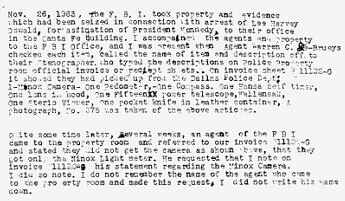

Dallas Assistant District Attorney William Alexander also confirms the existence of the Minox camera found in Oswald's sea bag:
The FBI denied the existence of a very small pocket Minox camera found among Oswald's belongings. We picked up a Minox camera which had some film in it and turned it over to the FBI. Despite their denials, claiming it was a light meter, I examined it, and I know a camera when I see one. We had the Minox camera and that was all there was to it! In those days, a Minox camera probably cost around $200. What inference can be drawn from it? Who knows, unless he was an intelligence buff and had bought it through a PX. Obviously, it leads to speculation about his being involved in some kind of intelligence.
(Larry Sneed's No More Silence pg. 551)
Finally, here is a page from a Dallas Police log book showing that they turned over a Minox camera to the FBI:
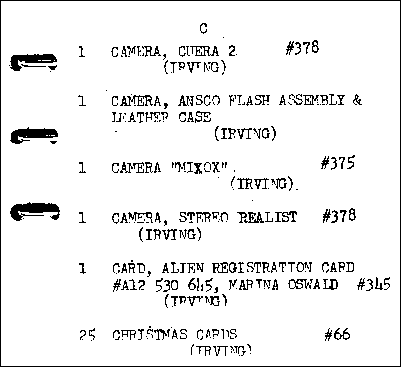
The November 25, 1963 Memo
On the day before the FBI officially took possession of the evidence, the FBI requested a comparison of the Minox film recovered from the possessions of Lee Harvey Oswald with another roll of Minox film, designated Q5.
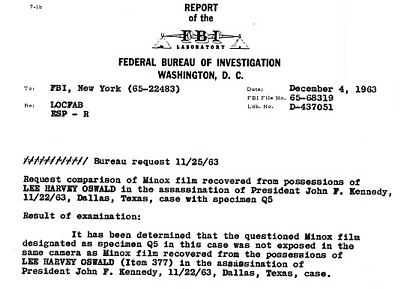
Note: LOCFAB ESP-R stands for LOCATION FOREIGN AGENTS BUREAU ESPIONAGE RUSSIA.
Item 377 on Property report G-11193 dated November 26, 1963 shows "two rolls apparently exposed Minox film":

These two rolls of Minox film (#377) appear to belong to the Paines, and are photographs of their European vacation. The FBI did not take possession of these films until 11/26/63. Therefore, the film recovered from Oswald's possessions on or before November 25th must be the roll of film recovered from the Minox camera found in Oswald's sea bag.
The Minox film belonging to the Paines was found in Minox containers that held two rolls of film. In the DPD evidence photo, a loose roll of Minox film can be seen by the case and name tags. The FBI returned the Minox case and name tags to Ruth Paine, but inexplicably, they were not part of the November 26th transfer. I believe the FBI had taken possession of these items (case, name tags, roll of film as well as the light meter that was substituted for the Minox camera) before the 25th of November. It is my opinion that this roll of film that came from Oswald's camera, and was the film the FBI lab compared to sample Q-5.
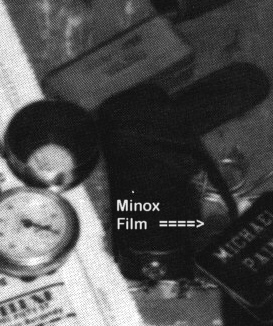
The Search for the Paine's Minox
On January 30, 1964, J. Edgar Hoover sent a memorandum to the Dallas SAC ordering an investigation into the matter of the missing Minox. It was the official position of the bureau that no Minox was recovered from the Paine house, but yet there was film and accessories that indicated that such a camera existed.

That same day, Ruth Paine was contacted and informed the Dallas office that her husband did own a Minox camera, but that it was no longer working. According to a report dated January 31, 1964 by SA Bardwell Odum:
He {Paine} owns a Minox camera and that camera is at his home in Irving, Texas. Several years ago he dropped this camera in salt water off the coast of Cape Cod, Massachusetts, and after retrieving it, soaking it in kerosine and cleaning same, it appeared to be in good working condition. Thereafter, someone bent the shutter by pulling the lens out too far, and, to the best of his knowledge, it is not now in working condition. He stated that he did have some cans of film, and that some of them were probably exposed film, but that the pictures made on this film were at least five years old. He stated that he had a case for the camera and other accessories including a light meter. He stated that when the police came to his house on November 22, 1963, they took the entire contents on a drawer containing photographic equipment which included the items mentioned above with the exception of the camera. He stated that this camera was in his garage at that time and that although he mentioned the camera to the police, they did not seem interested in it. He stated that he is sure LEE HARVEY OSWALD never used this camera, and he is of the opinion that it is not in working condition at the present time. Mr. Paine stated he had no knowledge of a 'no admittance' sign which was picked-up by the police at his residence. He stated this sign is not his and he has never seen it before." FBI DL 100-10461
A Minox III camera, serial number 27259, was turned over to the FBI on January 31, 1964, and was given the designation D-80.
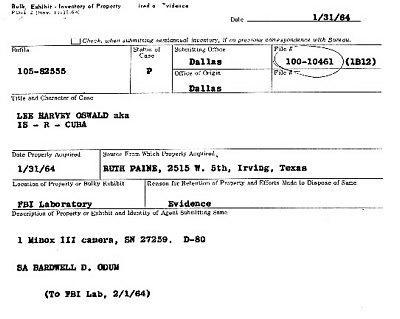
The inventory shows that the camera was acquired from Ruth Paine, as does CD 385 and CD 735. However, Ruth Paine later stated that she does not ever recall giving the camera to the FBI. Another FBI document, also dated January 31, 1964, shows that the camera was given to the FBI by Michael Paine.
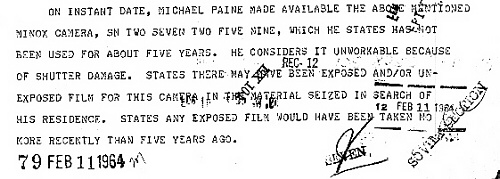
What happened to the Paine Minox??? According to Michael Paine, the camera was returned to him shortly after the assassination and was eventually stolen along with his other photographic equipment about five years later.
Marina's HSCA Testimony
When Marina Oswald Porter appeared before the House Select Committee on Assassinations, she was shown two Minox cameras and asked if she had ever seen either one before. One of the cameras, a model III with no serial number, came from the National Archives. The other Minox, described as a model I, serial #S2339303:
Q. This exhibit here which is identified as FBI exhibit D-80, does this look familiar to you?
A. No.
Q. And this camera here which is a Minox 1 :3.5 F-15 millimeter with the serial No. S2339303, does this look familiar to you?
A. No.
Q. Did you ever see any of the cameras before you in the possession of Lee?
A. I do not recall now at all the camera we used to have. The camera could be here but I would not recognize it at all.
Q. You just don't remember?
A. No.
Q. If I show you this camera which was Commission exhibit No. 750 and raise the top part so you can see there is a viewfinder and ask you just to look at the camera, would that refresh your recollection that that was the camera you allegedly took the photographs of Lee with?
A. Well, I honestly do not remember if I look straight at the object or look down.
Q. But seeing the camera today you still have no memory of what the camera looked like?
A. No; I am sorry I am unprofessional about it.
Q. Whatever your memory is, that is what we want to find out. A. I definitely never saw that before.
Q. Which are you referring to?
A. These two little ones.
Q. The record should note that she is referring to the Minox camera which is D-80 and the other Minox camera which is identified on the record as Minox 1 :3.5.
A. And by that I mean in my possession or Lee's possession.
Q. You never saw a camera like that?
A. No.
After some unrelated testimony about Lee Oswald's photography, Mr. Wolf returns to the subject of the two Minox cameras:
Mr. WOLF. Back on the record.
We are going to take a lunch break. At the current time it is approximately 12:40.
I would also like to state on the record that regarding the cameras that Mrs. Porter examined previously, concerning the two Minox cameras, so there is no confusion on the record, the Minox which was not part of the material in the National Archives and which has serial No. 2339303 is approximately 1 1/2 inches longer than the one which is currently in the National Archives.
At this time we will take a break for lunch.
[Whereupon, at 12:39 p.m., a recess was taken until 2: 15 p.m.]
There are several things to note in this exchange. First of all, the Minox III was referred to as exhibit D-80, which was the designation given to Michael Paine's Minox. But supposedly, D-80 had been returned to Paine, and by this time had been stolen. Could it be that the Oswald Minox became D-80 once the Paine Minox had been released from evidence??? Or was the wrong camera released to Michael Paine??? One thing's for certain, there is a Minox III in the Archives today.
But what of the other Minox displayed to Marina??? A model I would be the same size as a model III, not 1 1/2 inches longer. The only Minox to match that description would be a Model C, which was produced between 1969 and 1978.

Top Minox III - Bottom Minox C
A check of the serial number 2339303 proves that the camera is indeed a Minox C, a camera first manufactured six years after the assassination, and the current production model at the time of the HSCA. (Serial numbers for the model C range between 2300101 and 2473694). Why would the House Select Committee ask Marina to identify a camera that couldn't have possibly belonged to her husband???
The Minox in the Archives
Photo Courtesy of John Armstrong
In February 1999, I had the pleasure of discussing this matter by telephone with John Armstrong. I asked John if he could determine what model Minox was in the Archives, and after consulting one of his photographs of the Archives camera, he informed me that it was in fact a model III. The camera was housed in a ammo box, and was identified as DL-3, and not D-80. He then told me that when he handled the camera, it was far heavier than a Minox should be. When he tried to look inside the camera to check its serial number, he found that it had been filled with some substance that prohibited its being fully opened. Perhaps this explains why Mr. Wolf did not state the serial number of the Minox III when he showed it to Marina.
Since the serial number is located inside the Minox where the film is loaded (see photo below), the FBI had to open the camera to determine the Paine's Minox was #27259. And we know that Detective Rose opened the Minox he discovered in Oswald's sea bag and found a roll of film inside. That seems to indicate that the camera in the Archives has been sealed shut after it had been taken into evidence.

However, a check of Minox serial numbers shows that camera #27259 should be a Model II Minox, not the Model III that the FBI claimed they received from the Paine's. (Model II serial numbers ranged from 20379 to 31500 while Model III serial numbers started with 31275 and ended with 58499).The Model II, first manufactured in 1948, was never officially imported or sold in the United States.
Bardwell Odum's 1/31/64 report states that Paine's Minox was not working at that time because "...someone bent the shutter by pulling the lens out too far, and, to the best of his knowledge, it is not now in working condition." What is interesting about this description of the damage is that the lens can not be "pulled out" since it is contained within the camera, but the rear element of the lens does move back and forth inside the film chamber as the film is advanced and the shutter is cocked.
Technical note: the rear element of the lens actually presses up against the film as the photo is taken. When you advance the film by pulling the camera apart, the lens moves away from the film to allow it to move freely. One of the differences between a Minox II and a Minox III is the lens itself. The model II had a five element lens which sometimes caused scratches on the film because it extended a fraction too deep into the film chamber. Minox replaced the lens on the model III with a four element design which did not extend quite as far into the film chamber, allowing the film to advance freely without scratches.
Could this actually be the problem Michael Paine described to the FBI??? If the lens jammed in the picture taking position, it could conceivably prevent the advance mechanism from operating. This would be consistent with the damaged camera presently in the Archives. If the camera in the Archives is the Paine camera, and that camera was jammed shut when Michael Paine turned it over to the FBI in 1964, then the serial number recorded on Odum's inventory is a fabrication. Keep in mind that the the number 27259 traces back to a model II, not a model III like the Paine camera. Could it be that #27259 was actually a model II found among Oswald's possessions by Detective Rose???
A. J. Weberman and the Minox Photos
In 1978, researcher A. J. Weberman obtained copies of the Minox photos under an FOIA request. According to Weberman:
"The two rolls of Minox film that were taken with Michael Paine's Minox camera contained photos of a trip to Europe. The roll that was not taken with Michael Paine's camera seem to have been photographed in either Qemoy or Matsu. The photographs depicted several Marines horsing around on a large military vessel; a shot a tanker and LST-845P, shots of an island from offshore; shots entering a harbor; Asian children walking past a heavily fortified military base; a Chinese funeral passing the perimeter of the base, and a photo of OSWALD with an M-16."
Gerry Hemming and the Minox Photos
In January 1999, I received photocopies of the Minox photos from the National Archives. Each sheet of paper had one photo on it, except for one page. The main photo on that page appears to be one of the offshore photos that Weberman described with a couple of Marines in the foreground. Included on that page are two additional photos showing a serviceman wearing the same kind of hat as one of the Marines in the main photo.

Immediately, it struck me that the serviceman bore a resemblance to Gerry Patrick Hemming. The notion that Oswald might have taken photos of Hemming with his Minox while still overseas bore serious implications. After posting the photos on the JFK Research Forum, I heard from a well-respected researcher who suggested that I contact Hemming, who had learned about the photos from Noel Twyman.
Hemming's Story
Shortly afterwards, I spoke to Hemming who acknowledged that he was familiar with Minox photos of him, but that they were not taken by Oswald. He informed me that Howard Davis had a Minox, and used it to take photos of their camps. It was Davis who took the photos in question.
Hemming told me that the Minox camera found in Oswald's sea bag originally came from Life reporter Richard Billings, who later authored the HSCA report and co-authored Robert Blakey's The Plot to Kill the President. Billings, who reported on the commando raids for Life magazine, gave the Minox to Hemming to photograph their various missions. Hemming in turn gave the camera to Eddie Bayo who disappeared with nine commandos while on a raid into Cuba. Hemming refused to speculate on how the Minox got from Bayo to Oswald.
Hemming did speculate that the military photos were not taken overseas, but more likely they were photos taken during one of their Cuba missions. Hemming did claim that Oswald did possess a Minox while he was stationed at El Toro, and that he used it to take photos at the Cuban Consulate in Monterey Park. Hemming said that he knows that Oswald did not take that camera to Russia, but he has no idea what happened to that camera.
Assessment of the Facts
If the FBI story that Oswald did not possess a Minox is true, then that means:
-
Rose and Stovall were wrong when they claimed they found a Minox in Oswald's sea bag.
-
Assistant District Attorney Alexander was wrong when he said that he handled the Minox camera found by Dallas Police.
-
Agent DeBrueys was wrong when he identified item 375 as a Minox camera.
-
Agent DeBrueys and Dallas Police property manager H. W. Hill both signed the inventory showing a Minox camera. The exchange of evidence was also witnessed by Captain J. M. English as well as FBI agents Hosty and Howe. Not one of these experienced law enforcement agents noticed that the inventory was wrong.
-
Michael Paine was wrong when he reported that his camera had been returned to him shortly after the assassination.
There are several disturbing issues that point to evidence manipulation:
-
The FBI memorandum concerning the comparison of the films indicates that the FBI had possession of the Minox films on November 25, 1963, the day before they officially took possession of the evidence.
-
Although the film had been processed and compared to Q5 by December 4, 1963, Hoover's January 30th teletype claimed that the FBI laboratory presently maintained "two containers with exposed Minox film..."
-
Conflicting reports as to whether Michael or Ruth Paine actually gave the camera to the FBI.
-
Introduction of a bogus Minox C into the evidence.
-
John Armstrong's claim that the Minox camera in the Archives has been rigged not to open.
Here are links to the various documents:
-
Rose's handwritten evidence sheet of items taken from the Paine house.
-
DPD typed inventory of items taken from the Paine house.
-
Property report G-11192 showing Minox camera and signed by Warren DeBrueys.
-
Property report G-11193 showing Minox film and signed by Warren DeBrueys.
-
G. W. Hill's statement that he changed G-11192 at the request of the FBI.
-
FBI comparison of the Minox films.
-
Hoover teletype asking Dallas office to look for the Minox camera.
-
FBI report stating that Michael Paine turned over Minox camera.
-
FBI inventory showing Minox as exhibit D-80.
-
Gus Rose's HSCA deposition dealing with the Minox.
Go to the next page for more info about the disappearance of Oswald's Minox. Very important.
Click
Here to see an actual copy made by a Minox
Click
Here for a demonstration of the size of a Minox camera
EARL GOLZ
OSWALD CAMERA DISAPPEARED DURING FBI INVESTIGATION
By EARL GOLZ
A small German-made spy camera found among Lee Harvey Oswald's possessions by Dallas police disappeared when the FBI obtained the Oswald property less than a week after the assassination, The Dallas News has learned. Detective Gus Rose has told investigators with the House Assassinations Committee that he found the Minox camera, LOADED WITH FILM, in Oswald's seabag at the Irving home of Mr. and Mrs. Michael Paine on either Nov. 22 or Nov. 23, 1963. President John F. Kennedy was assassinated here Nov. 22. AFTER UNSUCCESSFULLY TRYING TO PRESSURE ROSE INTO REPORTING HE HAD FOUND A MINOX LIGHT METER AND NOT A MINOX CAMERA, THE FBI TWO MONTHS LATER PLACED INTO THEIR RECORDS A MINOX CAMERA WHICH THEY SAID WAS NOT OSWALD'S.
An FBI report said the Minox III camera was OBTAINED JAN. 31, 1964, from Mrs. Ruth Paine of Irving and that it belonged to her husband. Mrs. Paine's home was where Oswald's wife was staying at the time of the assassination and was where Rose said he found a Minox camera among Oswald's personal effects more than two months earlier.
MRS. PAINE TOLD THE NEWS SHE DOES NOT RECALL BEING ASKED TO TURN OVER A MINOX CAMERA TO THE FBI, although "I'm sure they (FBI) talked about it and what they did or what we did I just don't remember." Her husband owned a Minox badly in need of repair in 1964, BUT SHE COULD NOT RECALL THE FBI OR ANY OTHER LAW AUTHORITIES SEARCHING HER HOUSE OR GARAGE FOR IT AFTER THE DALLAS POLICE SEARCH OF NOV 22-23.
THE SERIAL NUMBER OF THE MINOX CAMERA REPORTEDLY OBTAINED FROM MRS. PAINE BY THE FBI WAS LISTED AS 27259, WHICH DID NOT EXIST AMONG ANY OF THE MINOX CAMERAS DISTRIBUTED FOR COMMERCIAL SALE IN THIS COUNTRY, according to Kurt Lohn, then in charge of distribution for Minox Corp. in New York City. All Minox cameras distributed in this country had six digits starting with serial number 135000, Lohn said, so 27259 "IS NOT A REGISTERED NUMBER...NOT A VALID NUMBER." Lohn said the "unobtrusive" camera is about three inches long and an inch wide and was used as a "spy camera" by both sides during World War II to photograph documents and other espionage work.
Oswald worked at the Dallas typesetting firm of Jaggars-Chiles-Stovall in 1962, which did CLASSIFIED work for the Army Map Service. There he learned to operate specialized photographic equipment at a job he took several months after returning from Russia, where he defected in 1959.
WHILE OSWALD WAS IN RUSSIA HE PHOTOGRAPHED A NUMBER OF MILITARY INSTALLATIONS AND OTHER SENSITIVE SCENES OF MORE INTEREST TO AN ESPIONAGE AGENT THAN A SIGHTSEER. THE PHOTOS, ALL TAKEN IN THE MINSK AREA WHERE OSWALD LIVED, SHOWED THE AIRPORT, AN ARMY OFFICE BUILDING, A POLYTECHNICAL INSTITUTE AND A RADIO-TELEVISION FACTORY ASSEMBLY LINE. FOR 14 YEARS THE FBI DID NOT EVEN REVEAL THE OSWALD PHOTOS IN RUSSIA EXISTED UNTIL REFERENCES TO THEM WERE DECLASSIFIED WITH OTHER ASSASSINATION DOCUMENTS LAST JANUARY. NEITHER THE PHOTOS THEMSELVES NOR THE LOCATION WHERE THE FBI FOUND THEM WAS REVEALED.
Rose, a 24-year veteran of the Dallas police force, said the camera he found "was real small, about like a half-pack of cigarettes in size" and was loaded with a cassette of film. He said he didn't know whether any of the film had been exposed. Rose's detective partner, R.S. Stovall, who helped in the search of the Paine house and garage, made an inventory of the property taken. Dallas police records show that Stovall itemized a "small German camera and black case on chain and film." Stovall, said cameras and camera equipment were found both in the house and in Oswald's seabag in the garage Nov. 22-23, but he could not recall where the German camera was found. He also said he remembers someone - "I think it was somebody from the FBI later on, asking about that deal" involving the camera and light meter. "They (FBI) were (later) calling it a light meter, I know that," Rose said. "But I know a camera when I see it....The thing we got at Irving out of Oswald's seabag was a Minox miniature camera. No question about it. "
They tried to get me to change the records because it wasn't a light meter. I don't know why they wanted it changed, but they must have had some motive for it." THE FBI'S REPORTED ACQUISITION OF A MINOX CAMERA FROM MRS. PAINE TWO MONTHS LATER OCCURRED AFTER NEWSMEN STARTED ASKING QUESTIONS ABOUT REPORTS THAT THE FBI WAS TRYING TO PRESSURE DALLAS POLICE INTO ALTERING THEIR INVENTORY OF OSWALD'S PROPERTY. Robert Gemberling, now retired FBI agent who wrote the first report submitted to the Warren Commission referring to the camera Mrs. Paine reportedly supplied to the FBI, said "if that's what the report says, I feel sure that's true. "It would stand to reason that if we found a light meter that would be used with a Minox camera then naturally, we would want to know where the camera is,"
Gemberling told The News. "Now Mr. Rose, I can't vouch - If he says he thought it was a camera and it was or whether he thought it wasn't, I just can't say. I don't know." J Gordon Shanklin, agent-in-charge of the Dallas FBI office during the assassination investigation, said he could not recall the camera incident. "I am sure it (camera or light meter) went up there (FBI lab in Washington), whatever it was," Shanklin said. "It's probably still in evidence. I don't know....But I am sure that if it had been a Minox camera and it was found, then it would have been reported as that."
AN INVENTORY OF PROPERTY TAKEN FROM THE PAINE HOUSE AND GARAGE WAS MADE NOV. 26, 1963, IN THE FBI OFFICE HERE AND LISTED "ONE MINOX CAMERA" UNDER ITEM NUMBER 375. THE INVENTORY WAS WITNESSED BY FBI AGENT WARREN DE BRUEYS AND DALLAS POLICE CAPT. J.M. ENGLISH. IN A SECOND PUBLISHED FBI INVENTORY AFTER DE BRUEYS AND ANOTHER AGENT, VINCENT DRAIN, DELIVERED THE PROPERTY TO THE FBI LABORATORY IN WASHINGTON ON NOV. 27, NO CAMERA WAS LISTED UNDER ITEM 375 BUT INSTEAD THE WORDS "MINOX LIGHT METER" APPEARED FOR THE FIRST TIME. ITEM 377 ON NOV. 26 LISTED 2 ROLLS OF UNDEVELOPED MINOX FILM AND TWO ROLLS OF "APPARENTLY EXPOSED" MINOX FILM. UNDER THE SAME ITEM ON NOV. 27 THE FBI INVENTORY READ TWO MINOX CASSETTES OR ROLLS "(ONE CONTAINING FILM)" AND TWO CONTAINERS WITH "UNEXPOSED" MINOX FILM. No description could be found in the Warren Commission volumes about whether the undeveloped film was developed to determine if any images were on the frames.
OSWALD PICTURES RELEASED BY FBI PHOTOGRAPHS FROM SMALL SPY CAMERA REVEALED AFTER ALMOST 15 YEARS
By EARL GOLZ
Photographs developed from Minox spy camera film found among Lee Harvey Oswald's personal possessions have been released by the FBI after being suppressed almost 15 years. About 25 images shot in foreign countries on two rolls from the miniature German-made camera were made available by the FBI under a Freedom of Information Act request by Alan Weberman, an independent assassination researcher in New York City.
More than 20 prints developed from one roll show civilian scenes apparently in Europe. Five shots from the other roll were military scenes either in the Far East or Central America. A Minox camera with a cassette film roll inside disappeared from Oswald's possessions after the FBI took custody of the property in 1963 from Dallas police, The News earlier had disclosed.
THE BUREAU LATER TRIED UNSUCCESSFULLY TO PRESSURE POLICE INTO CHANGING THEIR INVENTORY LIST TO READ MINOX LIGHT METER, NOT CAMERA, according to detective Gus Rose who said he found the camera in Oswald's seabag at the home of Mr. and Mrs. Michael Paine in Irving. The FBI had indicated the two rolls it developed were found separately in tin containers with ribbons tied around them. House Assassinations Committee investigators recently interviewed a former FBI agent who had custody of the Oswald property when the camera with film INSIDE DISAPPEARED, The New has learned. The former agent, Warren de Brueys, monitored Oswald's activities in the summer of 1963. He came to Dallas for two months to assist the Warren Commission investigation of the assassination.
"Monitoring is a word I would be reluctant to use," de Brueys told The News. "I never personally met him (Oswald), never knowingly personally talked to him. And I say that advisedly because - who knows - I don't think it happened. He may have called on the phone and made an inquiry one time without identifying himself."
THE HOUSE ASSASSINATIONS COMMITTEE HAS SPENT CONSIDERABLE TIME INVESTIGATION RECURRING RUMORS THAT OSWALD MAY HAVE BEEN AN INFORMANT FOR THE FBI OR CIA. COMMITTEE INVESTIGATORS RECENTLY TOOK THE DEPOSITION OF AN ACQUAINTANCE OF OSWALD IN NEW ORLEANS WHO SAID HE SAW AN UNIDENTIFIED FBI AGENT GIVE OSWALD A LARGE ENVELOPE FROM A PASSING GOVERNMENT CAR IN THE SUMMER OF 1963. FBI Director J. Edgar Hoover became so disturbed by the informant rumor that during the Warren Commission investigation in 1964 he ordered agents close to the Oswald case to sign affidavits denying Oswald was an FBI informant.
DE BRUEYS WAS NOT ONE OF THE AGENTS WHO SIGNED SUCH AN AFFIDAVIT. "I can state without any reservation that there was no collusion, no effort not to disclose anything," de Brueys said. "Nothing purposely, to my knowledge, was done to conceal anything. That would be the furthest thing in our minds at the time." De Brueys, however, said he has "my limitations as to what I can say....I have signed the secrecy agreement before leaving the bureau." He said he could not remember whether a Minox camera was in Oswald's possession. "There were quite a number of articles," de Brueys said. "I guess I spent all night cataloging those things and I at the moment can't remember that particular item, frankly."
A second inventory of Oswald's property was taken Nov. 27 after de Brueys and another FBI agent, Vincent Drain, personally delivered the two boxes of items to the FBI laboratory in Washington. No camera was listed under item 375 but the words "Minox light meter" appeared in its place. Item 377 in the Nov. 26 inventory listed two rolls of undeveloped Minox film and two rolls of "apparently exposed" Minox film. Under the same item on Nov. 27, the FBI inventory read two Minox cassettes or rolls "(one containing film)" and containers with "unexposed" Minox film.
The photos made available to Weberman were identified by the FBI as coming from item 377. THE BUREAU COVER LETTER TO WEBERMAN STATED THAT IT HAD NOT WITHHELD ANY OF THE PHOTOS "INASMUCH AS THE MATERIAL YOU REQUESTED IS OF GREAT HISTORICAL INTEREST." Three of the photos taken in a military environment in either the Far East or Central America were made from inside a barbed wire encampment showing civilians walking on the other side. Another shot was taken from a boat showing a tanker anchored offshore mountainous terrain. Oswald was stationed in Japan as a Marine in 1957 and 1958 and during that time went on a tour of duty to Taiwan, the Philippines, Corregidor and Indonesia.
The Minox camera, invented in the late 1930s in Latvia and later manufactured at plants in Germany, is about 3 inches long and 1 inch wide. It was used as a "spy camera" by both sides during World War II. FBI reports declassified earlier this year show the New York FBI office expressed an interest only three days after the assassination in the Minox film found in Oswald's possessions. THE NEW YORK OFFICE REQUESTED THE FBI LABORATORY IN WASHINGTON COMPARE THE OSWALD FILM WITH OTHER MINOX FILM, BUT THE LABORATORY DETERMINED THEY WERE NOT TAKEN WITH THE SAME CAMERA. THE NEW YORK REQUEST WAS MADE ONE DAY BEFORE DALLAS POLICE HAD TURNED OVER THE OSWALD PROPERTY TO DE BRUEYS.
TWO MONTHS LATER, ON JAN. 27, 1964, FBI AGENT THOMAS W. LENIHAN IN WASHINGTON TOLD J. GORDON SHANKLIN, AGENT IN CHARGE OF THE DALLAS FBI OFFICE, THAT DE BRUEYS' INVENTORY OF NOV. 26, 1963, SHOWED A MINOX CAMERA AMONG OSWALD'S POSSESSION, ACCORDING TO A LENIHAN MEMO. "I advised Shanklin that our laboratory claims that they did not have a Minox camera and that this item should be a Minox light meter," Lenihan's memo stated. "I requested that DL (Dallas FBI office) resolve whether or not a Minox camera was among the effects of Oswald. "
On 1-28-64 Shanklin advised Inspector Moore (Dallas police detective H.M. Moore) that Oswald did not have a Minox camera; that this was a Minox light meter." Two days after Lenihan told Shanklin the camera was a light meter, FBI agents visited the Paine home in Irving where Oswald's personal possessions were found and located a Minox camera in a coffee can in the garage. Mrs. Ruth Paine identified the camera as her husband's. The camera, which Michael Paine considered "unworkable" because of shutter damage, was forwarded to the Washington FBI office with "other evidence," according to an FBI teleprinter message dated Jan. 31, 1964. The message said Dallas police were "aware that no Minox camera (was) obtained in search" of the Paine residence and garage on Nov. 22-23, 1963. Detective Rose, however, remains adamant he found a Minox camera with film in it in Oswald's seabag when he made the initial search at the Paine home.
Michael Paine told The News he recalled taking photos in Korea while he was in the army in the early 1950s and later on a trip to Europe, but not with a Minox camera. He couldn't remember taking a photo of a tanker anchored offshore mountainous terrain, he said.
EARL GOLZ
OSWALD CAMERA DISAPPEARED DURING FBI INVESTIGATION
By EARL GOLZ
A small German-made spy camera found among Lee Harvey Oswald's possessions by Dallas police disappeared when the FBI obtained the Oswald property less than a week after the assassination, The Dallas News has learned. Detective Gus Rose has told investigators with the House Assassinations Committee that he found the Minox camera, LOADED WITH FILM, in Oswald's seabag at the Irving home of Mr. and Mrs. Michael Paine on either Nov. 22 or Nov. 23, 1963. President John F. Kennedy was assassinated here Nov. 22. AFTER UNSUCCESSFULLY TRYING TO PRESSURE ROSE INTO REPORTING HE HAD FOUND A MINOX LIGHT METER AND NOT A MINOX CAMERA, THE FBI TWO MONTHS LATER PLACED INTO THEIR RECORDS A MINOX CAMERA WHICH THEY SAID WAS NOT OSWALD'S.
An FBI report said the Minox III camera was OBTAINED JAN. 31, 1964, from Mrs. Ruth Paine of Irving and that it belonged to her husband. Mrs. Paine's home was where Oswald's wife was staying at the time of the assassination and was where Rose said he found a Minox camera among Oswald's personal effects more than two months earlier.
MRS. PAINE TOLD THE NEWS SHE DOES NOT RECALL BEING ASKED TO TURN OVER A MINOX CAMERA TO THE FBI, although "I'm sure they (FBI) talked about it and what they did or what we did I just don't remember." Her husband owned a Minox badly in need of repair in 1964, BUT SHE COULD NOT RECALL THE FBI OR ANY OTHER LAW AUTHORITIES SEARCHING HER HOUSE OR GARAGE FOR IT AFTER THE DALLAS POLICE SEARCH OF NOV 22-23.
THE SERIAL NUMBER OF THE MINOX CAMERA REPORTEDLY OBTAINED FROM MRS. PAINE BY THE FBI WAS LISTED AS 27259, WHICH DID NOT EXIST AMONG ANY OF THE MINOX CAMERAS DISTRIBUTED FOR COMMERCIAL SALE IN THIS COUNTRY, according to Kurt Lohn, then in charge of distribution for Minox Corp. in New York City. All Minox cameras distributed in this country had six digits starting with serial number 135000, Lohn said, so 27259 "IS NOT A REGISTERED NUMBER...NOT A VALID NUMBER." Lohn said the "unobtrusive" camera is about three inches long and an inch wide and was used as a "spy camera" by both sides during World War II to photograph documents and other espionage work.
Oswald worked at the Dallas typesetting firm of Jaggars-Chiles-Stovall in 1962, which did CLASSIFIED work for the Army Map Service. There he learned to operate specialized photographic equipment at a job he took several months after returning from Russia, where he defected in 1959.
WHILE OSWALD WAS IN RUSSIA HE PHOTOGRAPHED A NUMBER OF MILITARY INSTALLATIONS AND OTHER SENSITIVE SCENES OF MORE INTEREST TO AN ESPIONAGE AGENT THAN A SIGHTSEER. THE PHOTOS, ALL TAKEN IN THE MINSK AREA WHERE OSWALD LIVED, SHOWED THE AIRPORT, AN ARMY OFFICE BUILDING, A POLYTECHNICAL INSTITUTE AND A RADIO-TELEVISION FACTORY ASSEMBLY LINE. FOR 14 YEARS THE FBI DID NOT EVEN REVEAL THE OSWALD PHOTOS IN RUSSIA EXISTED UNTIL REFERENCES TO THEM WERE DECLASSIFIED WITH OTHER ASSASSINATION DOCUMENTS LAST JANUARY. NEITHER THE PHOTOS THEMSELVES NOR THE LOCATION WHERE THE FBI FOUND THEM WAS REVEALED.
Rose, a 24-year veteran of the Dallas police force, said the camera he found "was real small, about like a half-pack of cigarettes in size" and was loaded with a cassette of film. He said he didn't know whether any of the film had been exposed. Rose's detective partner, R.S. Stovall, who helped in the search of the Paine house and garage, made an inventory of the property taken. Dallas police records show that Stovall itemized a "small German camera and black case on chain and film." Stovall, said cameras and camera equipment were found both in the house and in Oswald's seabag in the garage Nov. 22-23, but he could not recall where the German camera was found. He also said he remembers someone - "I think it was somebody from the FBI later on, asking about that deal" involving the camera and light meter. "They (FBI) were (later) calling it a light meter, I know that," Rose said. "But I know a camera when I see it....The thing we got at Irving out of Oswald's seabag was a Minox miniature camera. No question about it. "
They tried to get me to change the records because it wasn't a light meter. I don't know why they wanted it changed, but they must have had some motive for it." THE FBI'S REPORTED ACQUISITION OF A MINOX CAMERA FROM MRS. PAINE TWO MONTHS LATER OCCURRED AFTER NEWSMEN STARTED ASKING QUESTIONS ABOUT REPORTS THAT THE FBI WAS TRYING TO PRESSURE DALLAS POLICE INTO ALTERING THEIR INVENTORY OF OSWALD'S PROPERTY. Robert Gemberling, now retired FBI agent who wrote the first report submitted to the Warren Commission referring to the camera Mrs. Paine reportedly supplied to the FBI, said "if that's what the report says, I feel sure that's true. "It would stand to reason that if we found a light meter that would be used with a Minox camera then naturally, we would want to know where the camera is,"
Gemberling told The News. "Now Mr. Rose, I can't vouch - If he says he thought it was a camera and it was or whether he thought it wasn't, I just can't say. I don't know." J Gordon Shanklin, agent-in-charge of the Dallas FBI office during the assassination investigation, said he could not recall the camera incident. "I am sure it (camera or light meter) went up there (FBI lab in Washington), whatever it was," Shanklin said. "It's probably still in evidence. I don't know....But I am sure that if it had been a Minox camera and it was found, then it would have been reported as that."
AN INVENTORY OF PROPERTY TAKEN FROM THE PAINE HOUSE AND GARAGE WAS MADE NOV. 26, 1963, IN THE FBI OFFICE HERE AND LISTED "ONE MINOX CAMERA" UNDER ITEM NUMBER 375. THE INVENTORY WAS WITNESSED BY FBI AGENT WARREN DE BRUEYS AND DALLAS POLICE CAPT. J.M. ENGLISH. IN A SECOND PUBLISHED FBI INVENTORY AFTER DE BRUEYS AND ANOTHER AGENT, VINCENT DRAIN, DELIVERED THE PROPERTY TO THE FBI LABORATORY IN WASHINGTON ON NOV. 27, NO CAMERA WAS LISTED UNDER ITEM 375 BUT INSTEAD THE WORDS "MINOX LIGHT METER" APPEARED FOR THE FIRST TIME. ITEM 377 ON NOV. 26 LISTED 2 ROLLS OF UNDEVELOPED MINOX FILM AND TWO ROLLS OF "APPARENTLY EXPOSED" MINOX FILM. UNDER THE SAME ITEM ON NOV. 27 THE FBI INVENTORY READ TWO MINOX CASSETTES OR ROLLS "(ONE CONTAINING FILM)" AND TWO CONTAINERS WITH "UNEXPOSED" MINOX FILM. No description could be found in the Warren Commission volumes about whether the undeveloped film was developed to determine if any images were on the frames.
OSWALD PICTURES RELEASED BY FBI PHOTOGRAPHS FROM SMALL SPY CAMERA REVEALED AFTER ALMOST 15 YEARS
By EARL GOLZ
Photographs developed from Minox spy camera film found among Lee Harvey Oswald's personal possessions have been released by the FBI after being suppressed almost 15 years. About 25 images shot in foreign countries on two rolls from the miniature German-made camera were made available by the FBI under a Freedom of Information Act request by Alan Weberman, an independent assassination researcher in New York City.
More than 20 prints developed from one roll show civilian scenes apparently in Europe. Five shots from the other roll were military scenes either in the Far East or Central America. A Minox camera with a cassette film roll inside disappeared from Oswald's possessions after the FBI took custody of the property in 1963 from Dallas police, The News earlier had disclosed.
THE BUREAU LATER TRIED UNSUCCESSFULLY TO PRESSURE POLICE INTO CHANGING THEIR INVENTORY LIST TO READ MINOX LIGHT METER, NOT CAMERA, according to detective Gus Rose who said he found the camera in Oswald's seabag at the home of Mr. and Mrs. Michael Paine in Irving. The FBI had indicated the two rolls it developed were found separately in tin containers with ribbons tied around them. House Assassinations Committee investigators recently interviewed a former FBI agent who had custody of the Oswald property when the camera with film INSIDE DISAPPEARED, The New has learned. The former agent, Warren de Brueys, monitored Oswald's activities in the summer of 1963. He came to Dallas for two months to assist the Warren Commission investigation of the assassination.
"Monitoring is a word I would be reluctant to use," de Brueys told The News. "I never personally met him (Oswald), never knowingly personally talked to him. And I say that advisedly because - who knows - I don't think it happened. He may have called on the phone and made an inquiry one time without identifying himself."
THE HOUSE ASSASSINATIONS COMMITTEE HAS SPENT CONSIDERABLE TIME INVESTIGATION RECURRING RUMORS THAT OSWALD MAY HAVE BEEN AN INFORMANT FOR THE FBI OR CIA. COMMITTEE INVESTIGATORS RECENTLY TOOK THE DEPOSITION OF AN ACQUAINTANCE OF OSWALD IN NEW ORLEANS WHO SAID HE SAW AN UNIDENTIFIED FBI AGENT GIVE OSWALD A LARGE ENVELOPE FROM A PASSING GOVERNMENT CAR IN THE SUMMER OF 1963. FBI Director J. Edgar Hoover became so disturbed by the informant rumor that during the Warren Commission investigation in 1964 he ordered agents close to the Oswald case to sign affidavits denying Oswald was an FBI informant.
DE BRUEYS WAS NOT ONE OF THE AGENTS WHO SIGNED SUCH AN AFFIDAVIT. "I can state without any reservation that there was no collusion, no effort not to disclose anything," de Brueys said. "Nothing purposely, to my knowledge, was done to conceal anything. That would be the furthest thing in our minds at the time." De Brueys, however, said he has "my limitations as to what I can say....I have signed the secrecy agreement before leaving the bureau." He said he could not remember whether a Minox camera was in Oswald's possession. "There were quite a number of articles," de Brueys said. "I guess I spent all night cataloging those things and I at the moment can't remember that particular item, frankly."
A second inventory of Oswald's property was taken Nov. 27 after de Brueys and another FBI agent, Vincent Drain, personally delivered the two boxes of items to the FBI laboratory in Washington. No camera was listed under item 375 but the words "Minox light meter" appeared in its place. Item 377 in the Nov. 26 inventory listed two rolls of undeveloped Minox film and two rolls of "apparently exposed" Minox film. Under the same item on Nov. 27, the FBI inventory read two Minox cassettes or rolls "(one containing film)" and containers with "unexposed" Minox film.
The photos made available to Weberman were identified by the FBI as coming from item 377. THE BUREAU COVER LETTER TO WEBERMAN STATED THAT IT HAD NOT WITHHELD ANY OF THE PHOTOS "INASMUCH AS THE MATERIAL YOU REQUESTED IS OF GREAT HISTORICAL INTEREST." Three of the photos taken in a military environment in either the Far East or Central America were made from inside a barbed wire encampment showing civilians walking on the other side. Another shot was taken from a boat showing a tanker anchored offshore mountainous terrain. Oswald was stationed in Japan as a Marine in 1957 and 1958 and during that time went on a tour of duty to Taiwan, the Philippines, Corregidor and Indonesia.
The Minox camera, invented in the late 1930s in Latvia and later manufactured at plants in Germany, is about 3 inches long and 1 inch wide. It was used as a "spy camera" by both sides during World War II. FBI reports declassified earlier this year show the New York FBI office expressed an interest only three days after the assassination in the Minox film found in Oswald's possessions. THE NEW YORK OFFICE REQUESTED THE FBI LABORATORY IN WASHINGTON COMPARE THE OSWALD FILM WITH OTHER MINOX FILM, BUT THE LABORATORY DETERMINED THEY WERE NOT TAKEN WITH THE SAME CAMERA. THE NEW YORK REQUEST WAS MADE ONE DAY BEFORE DALLAS POLICE HAD TURNED OVER THE OSWALD PROPERTY TO DE BRUEYS.
TWO MONTHS LATER, ON JAN. 27, 1964, FBI AGENT THOMAS W. LENIHAN IN WASHINGTON TOLD J. GORDON SHANKLIN, AGENT IN CHARGE OF THE DALLAS FBI OFFICE, THAT DE BRUEYS' INVENTORY OF NOV. 26, 1963, SHOWED A MINOX CAMERA AMONG OSWALD'S POSSESSION, ACCORDING TO A LENIHAN MEMO. "I advised Shanklin that our laboratory claims that they did not have a Minox camera and that this item should be a Minox light meter," Lenihan's memo stated. "I requested that DL (Dallas FBI office) resolve whether or not a Minox camera was among the effects of Oswald. "
On 1-28-64 Shanklin advised Inspector Moore (Dallas police detective H.M. Moore) that Oswald did not have a Minox camera; that this was a Minox light meter." Two days after Lenihan told Shanklin the camera was a light meter, FBI agents visited the Paine home in Irving where Oswald's personal possessions were found and located a Minox camera in a coffee can in the garage. Mrs. Ruth Paine identified the camera as her husband's. The camera, which Michael Paine considered "unworkable" because of shutter damage, was forwarded to the Washington FBI office with "other evidence," according to an FBI teleprinter message dated Jan. 31, 1964. The message said Dallas police were "aware that no Minox camera (was) obtained in search" of the Paine residence and garage on Nov. 22-23, 1963. Detective Rose, however, remains adamant he found a Minox camera with film in it in Oswald's seabag when he made the initial search at the Paine home.
Michael Paine told The News he recalled taking photos in Korea while he was in the army in the early 1950s and later on a trip to Europe, but not with a Minox camera. He couldn't remember taking a photo of a tanker anchored offshore mountainous terrain, he said.
Below are 2 pages from "Harvey and Lee".
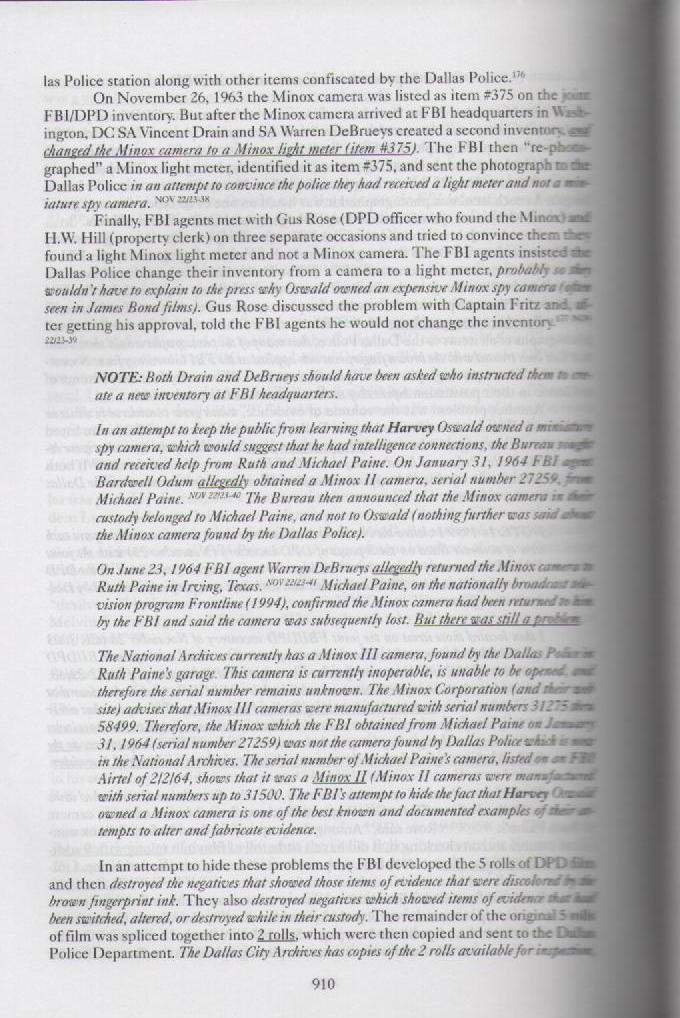
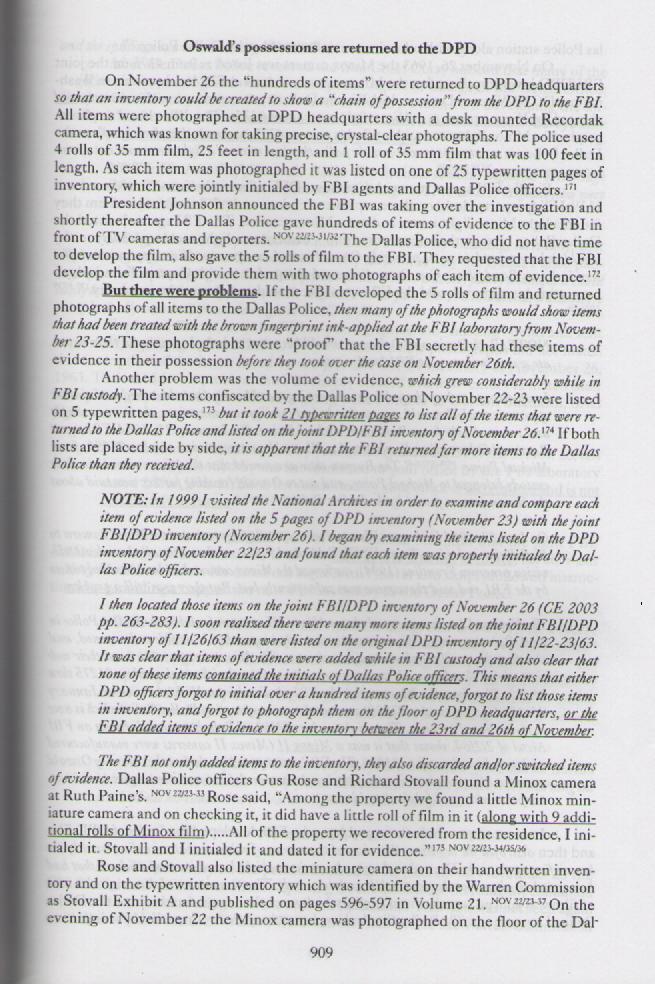
GEORGE AND THE CIA
Subject: Oswald a spy -- Minox Spy Camera
From: "Richard Booth"
Date: 3 Sep 1997 23:13:48 GMT
Message-id:
"Lee Harvey Oswald was smart as hell. They make a moron out of him.
Lee was the most honest man I knew. He was ahead of his time really, a
kind of hippie of those days. He would have gone to a black school like
this one if he could. And I will tell you this--I am sure he did not
shoot the
president." --Baron George De Mohrenshildt
CENTRAL INTELLIGENCE AGENCY
Former Field Operations Intelligence, CIA, and DIA operative Richard
Case Nagell was arrested in September 1963 for shooting up a bank.
Amoung items confiscated when he was arrested were Lee Harvey
Oswald's Department of Defense Uniformed Persons ID and a Fair Play
for Cuba Comittee leaflet.
Lee Oswald was not the only intelligence operative using the alias Alek
Hidell. In a 1976 sworn affidavit to the CIA, Richard Case Nagell listed
all aliases he had used in connection with his intelligence activities.
Listed amoung the names is Alek Hidell and Aleksei Hidell.
On March 29, 1977, shortly after an investigator for the HSCA tried to
contact him, George DeMohrenshildt was found dead from a shotgun
blast to the head. His death was ruled a suicide. DeMohrenshildt
revealed several facts pertaining to the assassination the very day of
his death. According to DeM, Dallas CIA official J. Walton Moore first
mentioned Oswald to him in late 1961--when Oswald was still in Minsk.
According to Richard Case Nagell and DeM himself, Demohrenshildt
"debriefed" Oswald for the CIA.
From August 1962 to October 1963, Richard Nagell was intermittently
employed as an informant and/or investigator for the CIA. In April of 1963,
Nagell conducted an inquiry concerning the marital status of Marina
Oswald and her reported desire to return to the USSR. During July, August
and September Nagell conducted an inquiry into the activities of Lee Harvey
Oswald, and the allegation that he had established a Fair Play for Cuba
Committee in New Orleans.
Former CIA finance officer James Wilcott testified to the House Select
Comittee on Assassinations in 1977 that "he learned that Oswald was
paid by the CIA while still stationed at Atsugi."
It was revealed in 1977 that the CIA had a "201 file"--a personnel file--on
Oswald. The CIA handed over a "virtually empty folder" on Oswald to the
HSCA, but an internal CIA document described Oswald's 201 file as filling
"two four-drawer safes."
Although Oswald was a high school dropout, his Russian was so good that
when he first met Marina, she thought he was a native-born Russian "with a
Baltic area accent." That kind of fluency suggests that Oswald got
extensive language training while in the Marines.
At the time of Oswald's trip to Russia in the autumn of 1959 he had $200 in
his bank account. The trip cost at least $1,500.
Oswald arrived in Helsinki Finland on October 11th 1959. He checked into
an expensive hotel and went to the Soviet consulate. There, Soviet consul
Gregory Golub issued Oswald a visa in only two days. The Warren
Commission would later determine that it normally took at least a week to
obtain a Soviet visa.
Antonio Veciana, one of the founder's of the violent Cuban exile group
called
Alpha 66 met repeatedly with his CIA contact named Maurice Bishop. It was
in late summer 1963 that Veciana met with Bishop and Lee Harvey Oswald
in Dallas, Texas.
On October 12, 1962 Oswald got hired to work at the Jaggers-Chiles-Stovall
photo lithography firm in Dallas. JCS was an interesting place for a
"redefector" from the USSR to find a job. One of the company's contracts
was
doing classified work for the U.S. Army Map Service. Just two days after
Oswald arrived at JCS, pictures taken by an American U-2 spy plane would
confirm the existence of Soviet missle launching pads. Technically, only
JCS workers with a special security clearance were allowed access to this
sensative material. In fact, office space was so small that Oswald could
readily
have seen it.
In Oswald's address book confiscated after the Kennedy assassination,
authorities found the notation "micro dots" written next to Oswald's entry
for
the JCS firm. Microdots, developed by German intelligence during WW2, are
a data-sending method wherein documents are photographically reduced to a
size that could be hidden under a postage stamp.
A tiny Minox "spy camera," originally manufactured in Nazi Germany and
used by both sides during WW2, was found amoung Oswald's effects when
Dallas police took possession of them after the assassination. Loaded with
film,
the camera was turned over to the FBI. According to detective Gus Rose, the
FBI later pressured the police to change their inventory records to make it
appear that only a light meter had been found. Oswald's camera simply
disappeared from FBI records.
In 1978, a Freedom of Information Act lawsuit forced the FBI to release
twenty-five pictures. The FBI indicated that two rolls it developed were
not
inside the Minox camera but found seperatly, in tin containers. Three
photos
showed some kind of military enviorment, either in the Far East of Central
America, inside a barbed-wire encampment where civilians walked outside.
Another picture had been taken from a boat, showing a tanker anchored
offshore from some mountainous terrain.
The FBI did not release, but made references to in files declassified in
1976,
photographs Oswald had also taken while in Minsk--of an airport, an Army
office building, a polytechnical institute, and a radio-TV factory assembly
line. Hundreds of dollars worth of photographic equipment were also
discovered by
the Dallas police in Oswald's apartment--three more cameras, a 15-power
telescope, two pairs of field glasses, a compass, even a pedometer.
On January 22, 1964, Warren Commission general counsel J. Lee Rankin
received a call from Waggoner Carr, the Texas attourney general. Carr
reported
that Dallas district attourney Henry Wade, a former FBI agent, had told him
that Oswald was recruited as an FBI informant in September 1962. Carr added
that
the FBI had paid Oswald $200 a month and had given him "Informant
Number S-179."
A 1974 Freedom of Information lawsuit by assassination researcher Harold
Weisberg revealed a top-secret transcript of a Warren Commission executive
session of January 27, 1964. A primary focus of discussion was information
received by Texas attorney general Waggoner Carr, indicating Oswald had
been getting two hundred dollars a month since September 1962 as informant
No. 179 on the FBI payroll. According to Warren Commission counsel Rankin,
the rumors were that Oswald's number had been "assigned to him in
connection with the CIA." The commission chose to dismiss rather than
pursue
this issue.
Rankin had received the same information from the Secret Service, who
"named
a Dallas deputy sheriff, Allan Sweatt, as it's source."
The name Lee Harvey Oswald in assosciation with the Fair Play for Cuba
Committee never appeared on the FBI "subversive list" despite the apparant
communist nature of the organization.
EARL GOLZ
OSWALD CAMERA DISAPPEARED DURING FBI INVESTIGATION
By EARL GOLZ
A small German-made spy camera found among Lee Harvey Oswald's possessions by Dallas police disappeared when the FBI obtained the Oswald property less than a week after the assassination, The Dallas News has learned. Detective Gus Rose has told investigators with the House Assassinations Committee that he found the Minox camera, LOADED WITH FILM, in Oswald's seabag at the Irving home of Mr. and Mrs. Michael Paine on either Nov. 22 or Nov. 23, 1963. President John F. Kennedy was assassinated here Nov. 22. AFTER UNSUCCESSFULLY TRYING TO PRESSURE ROSE INTO REPORTING HE HAD FOUND A MINOX LIGHT METER AND NOT A MINOX CAMERA, THE FBI TWO MONTHS LATER PLACED INTO THEIR RECORDS A MINOX CAMERA WHICH THEY SAID WAS NOT OSWALD'S.
An FBI report said the Minox III camera was OBTAINED JAN. 31, 1964, from Mrs. Ruth Paine of Irving and that it belonged to her husband. Mrs. Paine's home was where Oswald's wife was staying at the time of the assassination and was where Rose said he found a Minox camera among Oswald's personal effects more than two months earlier.
MRS. PAINE TOLD THE NEWS SHE DOES NOT RECALL BEING ASKED TO TURN OVER A MINOX CAMERA TO THE FBI, although "I'm sure they (FBI) talked about it and what they did or what we did I just don't remember." Her husband owned a Minox badly in need of repair in 1964, BUT SHE COULD NOT RECALL THE FBI OR ANY OTHER LAW AUTHORITIES SEARCHING HER HOUSE OR GARAGE FOR IT AFTER THE DALLAS POLICE SEARCH OF NOV 22-23.
THE SERIAL NUMBER OF THE MINOX CAMERA REPORTEDLY OBTAINED FROM MRS. PAINE BY THE FBI WAS LISTED AS 27259, WHICH DID NOT EXIST AMONG ANY OF THE MINOX CAMERAS DISTRIBUTED FOR COMMERCIAL SALE IN THIS COUNTRY, according to Kurt Lohn, then in charge of distribution for Minox Corp. in New York City. All Minox cameras distributed in this country had six digits starting with serial number 135000, Lohn said, so 27259 "IS NOT A REGISTERED NUMBER...NOT A VALID NUMBER." Lohn said the "unobtrusive" camera is about three inches long and an inch wide and was used as a "spy camera" by both sides during World War II to photograph documents and other espionage work.
Oswald worked at the Dallas typesetting firm of Jaggars-Chiles-Stovall in 1962, which did CLASSIFIED work for the Army Map Service. There he learned to operate specialized photographic equipment at a job he took several months after returning from Russia, where he defected in 1959.
WHILE OSWALD WAS IN RUSSIA HE PHOTOGRAPHED A NUMBER OF MILITARY INSTALLATIONS AND OTHER SENSITIVE SCENES OF MORE INTEREST TO AN ESPIONAGE AGENT THAN A SIGHTSEER. THE PHOTOS, ALL TAKEN IN THE MINSK AREA WHERE OSWALD LIVED, SHOWED THE AIRPORT, AN ARMY OFFICE BUILDING, A POLYTECHNICAL INSTITUTE AND A RADIO-TELEVISION FACTORY ASSEMBLY LINE. FOR 14 YEARS THE FBI DID NOT EVEN REVEAL THE OSWALD PHOTOS IN RUSSIA EXISTED UNTIL REFERENCES TO THEM WERE DECLASSIFIED WITH OTHER ASSASSINATION DOCUMENTS LAST JANUARY. NEITHER THE PHOTOS THEMSELVES NOR THE LOCATION WHERE THE FBI FOUND THEM WAS REVEALED.
Rose, a 24-year veteran of the Dallas police force, said the camera he found "was real small, about like a half-pack of cigarettes in size" and was loaded with a cassette of film. He said he didn't know whether any of the film had been exposed. Rose's detective partner, R.S. Stovall, who helped in the search of the Paine house and garage, made an inventory of the property taken. Dallas police records show that Stovall itemized a "small German camera and black case on chain and film." Stovall, said cameras and camera equipment were found both in the house and in Oswald's seabag in the garage Nov. 22-23, but he could not recall where the German camera was found. He also said he remembers someone - "I think it was somebody from the FBI later on, asking about that deal" involving the camera and light meter. "They (FBI) were (later) calling it a light meter, I know that," Rose said. "But I know a camera when I see it....The thing we got at Irving out of Oswald's seabag was a Minox miniature camera. No question about it. "
They tried to get me to change the records because it wasn't a light meter. I don't know why they wanted it changed, but they must have had some motive for it." THE FBI'S REPORTED ACQUISITION OF A MINOX CAMERA FROM MRS. PAINE TWO MONTHS LATER OCCURRED AFTER NEWSMEN STARTED ASKING QUESTIONS ABOUT REPORTS THAT THE FBI WAS TRYING TO PRESSURE DALLAS POLICE INTO ALTERING THEIR INVENTORY OF OSWALD'S PROPERTY. Robert Gemberling, now retired FBI agent who wrote the first report submitted to the Warren Commission referring to the camera Mrs. Paine reportedly supplied to the FBI, said "if that's what the report says, I feel sure that's true. "It would stand to reason that if we found a light meter that would be used with a Minox camera then naturally, we would want to know where the camera is,"
Gemberling told The News. "Now Mr. Rose, I can't vouch - If he says he thought it was a camera and it was or whether he thought it wasn't, I just can't say. I don't know." J Gordon Shanklin, agent-in-charge of the Dallas FBI office during the assassination investigation, said he could not recall the camera incident. "I am sure it (camera or light meter) went up there (FBI lab in Washington), whatever it was," Shanklin said. "It's probably still in evidence. I don't know....But I am sure that if it had been a Minox camera and it was found, then it would have been reported as that."
AN INVENTORY OF PROPERTY TAKEN FROM THE PAINE HOUSE AND GARAGE WAS MADE NOV. 26, 1963, IN THE FBI OFFICE HERE AND LISTED "ONE MINOX CAMERA" UNDER ITEM NUMBER 375. THE INVENTORY WAS WITNESSED BY FBI AGENT WARREN DE BRUEYS AND DALLAS POLICE CAPT. J.M. ENGLISH. IN A SECOND PUBLISHED FBI INVENTORY AFTER DE BRUEYS AND ANOTHER AGENT, VINCENT DRAIN, DELIVERED THE PROPERTY TO THE FBI LABORATORY IN WASHINGTON ON NOV. 27, NO CAMERA WAS LISTED UNDER ITEM 375 BUT INSTEAD THE WORDS "MINOX LIGHT METER" APPEARED FOR THE FIRST TIME. ITEM 377 ON NOV. 26 LISTED 2 ROLLS OF UNDEVELOPED MINOX FILM AND TWO ROLLS OF "APPARENTLY EXPOSED" MINOX FILM. UNDER THE SAME ITEM ON NOV. 27 THE FBI INVENTORY READ TWO MINOX CASSETTES OR ROLLS "(ONE CONTAINING FILM)" AND TWO CONTAINERS WITH "UNEXPOSED" MINOX FILM. No description could be found in the Warren Commission volumes about whether the undeveloped film was developed to determine if any images were on the frames.
OSWALD PICTURES RELEASED BY FBI PHOTOGRAPHS FROM SMALL SPY CAMERA REVEALED AFTER ALMOST 15 YEARS
By EARL GOLZ
Photographs developed from Minox spy camera film found among Lee Harvey Oswald's personal possessions have been released by the FBI after being suppressed almost 15 years. About 25 images shot in foreign countries on two rolls from the miniature German-made camera were made available by the FBI under a Freedom of Information Act request by Alan Weberman, an independent assassination researcher in New York City.
More than 20 prints developed from one roll show civilian scenes apparently in Europe. Five shots from the other roll were military scenes either in the Far East or Central America. A Minox camera with a cassette film roll inside disappeared from Oswald's possessions after the FBI took custody of the property in 1963 from Dallas police, The News earlier had disclosed.
THE BUREAU LATER TRIED UNSUCCESSFULLY TO PRESSURE POLICE INTO CHANGING THEIR INVENTORY LIST TO READ MINOX LIGHT METER, NOT CAMERA, according to detective Gus Rose who said he found the camera in Oswald's seabag at the home of Mr. and Mrs. Michael Paine in Irving. The FBI had indicated the two rolls it developed were found separately in tin containers with ribbons tied around them. House Assassinations Committee investigators recently interviewed a former FBI agent who had custody of the Oswald property when the camera with film INSIDE DISAPPEARED, The New has learned. The former agent, Warren de Brueys, monitored Oswald's activities in the summer of 1963. He came to Dallas for two months to assist the Warren Commission investigation of the assassination.
"Monitoring is a word I would be reluctant to use," de Brueys told The News. "I never personally met him (Oswald), never knowingly personally talked to him. And I say that advisedly because - who knows - I don't think it happened. He may have called on the phone and made an inquiry one time without identifying himself."
THE HOUSE ASSASSINATIONS COMMITTEE HAS SPENT CONSIDERABLE TIME INVESTIGATION RECURRING RUMORS THAT OSWALD MAY HAVE BEEN AN INFORMANT FOR THE FBI OR CIA. COMMITTEE INVESTIGATORS RECENTLY TOOK THE DEPOSITION OF AN ACQUAINTANCE OF OSWALD IN NEW ORLEANS WHO SAID HE SAW AN UNIDENTIFIED FBI AGENT GIVE OSWALD A LARGE ENVELOPE FROM A PASSING GOVERNMENT CAR IN THE SUMMER OF 1963. FBI Director J. Edgar Hoover became so disturbed by the informant rumor that during the Warren Commission investigation in 1964 he ordered agents close to the Oswald case to sign affidavits denying Oswald was an FBI informant.
DE BRUEYS WAS NOT ONE OF THE AGENTS WHO SIGNED SUCH AN AFFIDAVIT. "I can state without any reservation that there was no collusion, no effort not to disclose anything," de Brueys said. "Nothing purposely, to my knowledge, was done to conceal anything. That would be the furthest thing in our minds at the time." De Brueys, however, said he has "my limitations as to what I can say....I have signed the secrecy agreement before leaving the bureau." He said he could not remember whether a Minox camera was in Oswald's possession. "There were quite a number of articles," de Brueys said. "I guess I spent all night cataloging those things and I at the moment can't remember that particular item, frankly."
A second inventory of Oswald's property was taken Nov. 27 after de Brueys and another FBI agent, Vincent Drain, personally delivered the two boxes of items to the FBI laboratory in Washington. No camera was listed under item 375 but the words "Minox light meter" appeared in its place. Item 377 in the Nov. 26 inventory listed two rolls of undeveloped Minox film and two rolls of "apparently exposed" Minox film. Under the same item on Nov. 27, the FBI inventory read two Minox cassettes or rolls "(one containing film)" and containers with "unexposed" Minox film.
The photos made available to Weberman were identified by the FBI as coming from item 377. THE BUREAU COVER LETTER TO WEBERMAN STATED THAT IT HAD NOT WITHHELD ANY OF THE PHOTOS "INASMUCH AS THE MATERIAL YOU REQUESTED IS OF GREAT HISTORICAL INTEREST." Three of the photos taken in a military environment in either the Far East or Central America were made from inside a barbed wire encampment showing civilians walking on the other side. Another shot was taken from a boat showing a tanker anchored offshore mountainous terrain. Oswald was stationed in Japan as a Marine in 1957 and 1958 and during that time went on a tour of duty to Taiwan, the Philippines, Corregidor and Indonesia.
The Minox camera, invented in the late 1930s in Latvia and later manufactured at plants in Germany, is about 3 inches long and 1 inch wide. It was used as a "spy camera" by both sides during World War II. FBI reports declassified earlier this year show the New York FBI office expressed an interest only three days after the assassination in the Minox film found in Oswald's possessions. THE NEW YORK OFFICE REQUESTED THE FBI LABORATORY IN WASHINGTON COMPARE THE OSWALD FILM WITH OTHER MINOX FILM, BUT THE LABORATORY DETERMINED THEY WERE NOT TAKEN WITH THE SAME CAMERA. THE NEW YORK REQUEST WAS MADE ONE DAY BEFORE DALLAS POLICE HAD TURNED OVER THE OSWALD PROPERTY TO DE BRUEYS.
TWO MONTHS LATER, ON JAN. 27, 1964, FBI AGENT THOMAS W. LENIHAN IN WASHINGTON TOLD J. GORDON SHANKLIN, AGENT IN CHARGE OF THE DALLAS FBI OFFICE, THAT DE BRUEYS' INVENTORY OF NOV. 26, 1963, SHOWED A MINOX CAMERA AMONG OSWALD'S POSSESSION, ACCORDING TO A LENIHAN MEMO. "I advised Shanklin that our laboratory claims that they did not have a Minox camera and that this item should be a Minox light meter," Lenihan's memo stated. "I requested that DL (Dallas FBI office) resolve whether or not a Minox camera was among the effects of Oswald. "
On 1-28-64 Shanklin advised Inspector Moore (Dallas police detective H.M. Moore) that Oswald did not have a Minox camera; that this was a Minox light meter." Two days after Lenihan told Shanklin the camera was a light meter, FBI agents visited the Paine home in Irving where Oswald's personal possessions were found and located a Minox camera in a coffee can in the garage. Mrs. Ruth Paine identified the camera as her husband's. The camera, which Michael Paine considered "unworkable" because of shutter damage, was forwarded to the Washington FBI office with "other evidence," according to an FBI teleprinter message dated Jan. 31, 1964. The message said Dallas police were "aware that no Minox camera (was) obtained in search" of the Paine residence and garage on Nov. 22-23, 1963. Detective Rose, however, remains adamant he found a Minox camera with film in it in Oswald's seabag when he made the initial search at the Paine home.
Michael Paine told The News he recalled taking photos in Korea while he was in the army in the early 1950s and later on a trip to Europe, but not with a Minox camera. He couldn't remember taking a photo of a tanker anchored offshore mountainous terrain, he said.
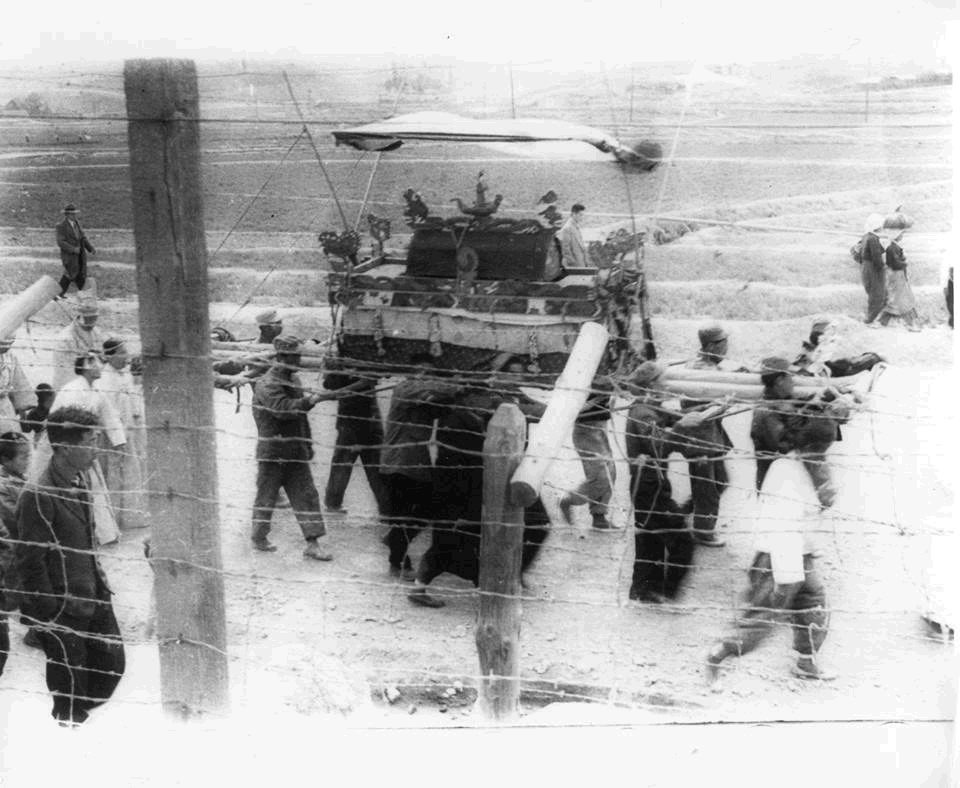
BOVE IS A PHOTO OF A FUNERAL PROCESSION SOMEWHERE IN THE ORIENT.
MICHAEL PAIN TESTIFIED THAT HE TOOK PICTURES WITH HIS MINOX AT CAPE COD MASSACHESUTTS AND EUROPE "ONLY".
WE KNOW THAT OSWAD SERVED IN JAPAN AND, THE PHILIPINNES.
Contact Information tomnln@cox.net
Page Visited
Times


